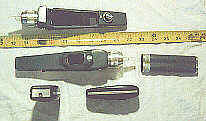The Copycats -- Part 2: The Brad Nelson Story
Page 3

At any rate, from 1974 to 1977 Brad produced a reasonably modest amount of
these pieces, but unfortunately for the collector, each replica took 4-5 weeks to make, so
the price steadily went up. By the end of 1977 Brad's phasers were now $500.00, and at almost that
exact same point in time, The Great Bird Of The Galaxy (Gene Roddenberry) swooped down to
attend a Statler-Hilton Star Trek convention.
"Hey, Mr. Roddenberry" shouted a fan, "you gotta checkout the
dealers room, someone's got one of your working phasers in there". "I'll do that
" said Gene. Actually, Mr. Roddenberry had already heard about Brad's phaser, and was
planning to stop by anyway. As Brad was demonstrating his phaser to a prospective
customer, someone said "Excuse me, but may I see that when you are through?" Now
when The Great Bird speaks, we all listen.."Well young man, I guess my friends were
right. You did a fine job...Better than the guys I hired to do these for me......What's
your name???.. I'll remember that..Do you have a card"? "No" said Brad,
"but I"ll put my telephone number on my order form for you".
Gene Roddenberry definitely had a way with the people that he spoke with. He
put you on equal ground with him, and made you feel comfortable, and never exercised any
superior airs. You immediately felt like you were talking to an old friend.
"Well" said Gene, "can I buy this one?" "Of course" said
Brad, who usually only brought one phaser to the shows as a demo model, and shipped the
customer his when he placed his order. But the Great Bird of the Galaxy should not be made
to wait!!! "Thank you...we'll be in touch"...and off he went.
It is believed that very late in 1977 or early in 1978 Brad's telephone
rang at home. "This is Gene Roddenberry..maybe you remember me...I bought
one of your phasers". Now that's a call from a copycat's dreams. It seemed
that Gene was finally going to bring back Star Trek as a made for TV miniseries
entitled Star Trek: Phase 2 and wanted Brad to make the phasers that they were
going to use. "Sure!" jumped Brad. However Gene wanted some changes.
Originally Brad used gloss paints on his pieces. Gene requested flats. Mr. Roddenberry
also wanted Brad to do away with the rainbow colored square grid on top of the
phaser 1 to be changed to an all chrome colored straight lined tape, and to
cut down the back knob that was the selector switch. In addition there were
a few more subtle changes he wanted made that would further distinguish these
pieces from the fan bought ones: Gene needed none of the electronics, and he
wanted the phaser 1 to be removable, along with the pistol grip that housed
the AA batteries. Brad used velcro to accomplish these changes and sewed it
through with copper thread and went over the thread with black magic marker.
After they were made, Brad personally went to Paramount Studios, and
hand delivered them. Sometime after that, Brad was summoned to Paramount's legal
offices for a series of three meetings. Apparently Gene Roddenberry was unaware
of the fact that Paramount had given a license to sell Star Trek merchandise
to Mego Toys. That also included the name "Phaser". The way it was
explained to Brad this fell under the legal nomenclature of "conspiracy
to confuse the public" and therefore his Phasers could not be used, since
Mego's toy phaser was vastly different in appearance from Brad's full sized
realistic looking replica.
Apparently Paramount and/or Remco must have thought that the
fans were just too ignorant to see the difference from a cheap
inaccurate children's toy versus an authentic in-scale prop
replica worthy enough to be used on TV or
even a movie!
I don't know about you readers, but except for shows like "Lost In
Space" I have yet to see any character use a cheap kids toy for a prop, since most
studios, if not all, utilize their special effects department to construct what they
need... Guess what Paramount, we can tell the difference!!.
However, the real reason may have been the fact that Paramount studios always
had a profound dislike of Gene Roddenberry's use of "nonprofessionals" for prop
work, and were looking for an excuse not to allow it this time. In any case, Brad never
saw those phasers he made for Gene Roddenberry again, but continued to make more as time
permitted him, but stopped briefly for a period at approximately 1983.
His last and final Hurrah was at a Toronto Canada Star Trek convention in 1985.
By that time the parts he was using for the electronics became outdated and becoming more
difficult to acquire. Collectors were paying up to $700.00 each for one which was a little
high, but in this author's opinion, still worth it. In light of these reasons Brad decided
to shut down Starfleet Research. He felt he had a good run of it, and that it was now time
to move on to bigger and better things. At present he works in silicon valley for an
electronics firm, where his expertise took him as far as Australia, recently. But he still
remembers fondly the possibility of his phasers being used by Captain Kirk and
Crew...to paraphrase a quote from a classic Klingon: "It might have been
glorious."
It should also be noted that Brad Nelson was also
afforded the rare privilege of being contacted by the Smithsonian Museum In Washington
D.C. in 1978, and asked if he would donate one of his phasers for their collection of
memorabilia. As of this date, it is not on display, however it is confirmed that they
still have one in their possession from that date.
Copycats, the sincerest form of flattery









